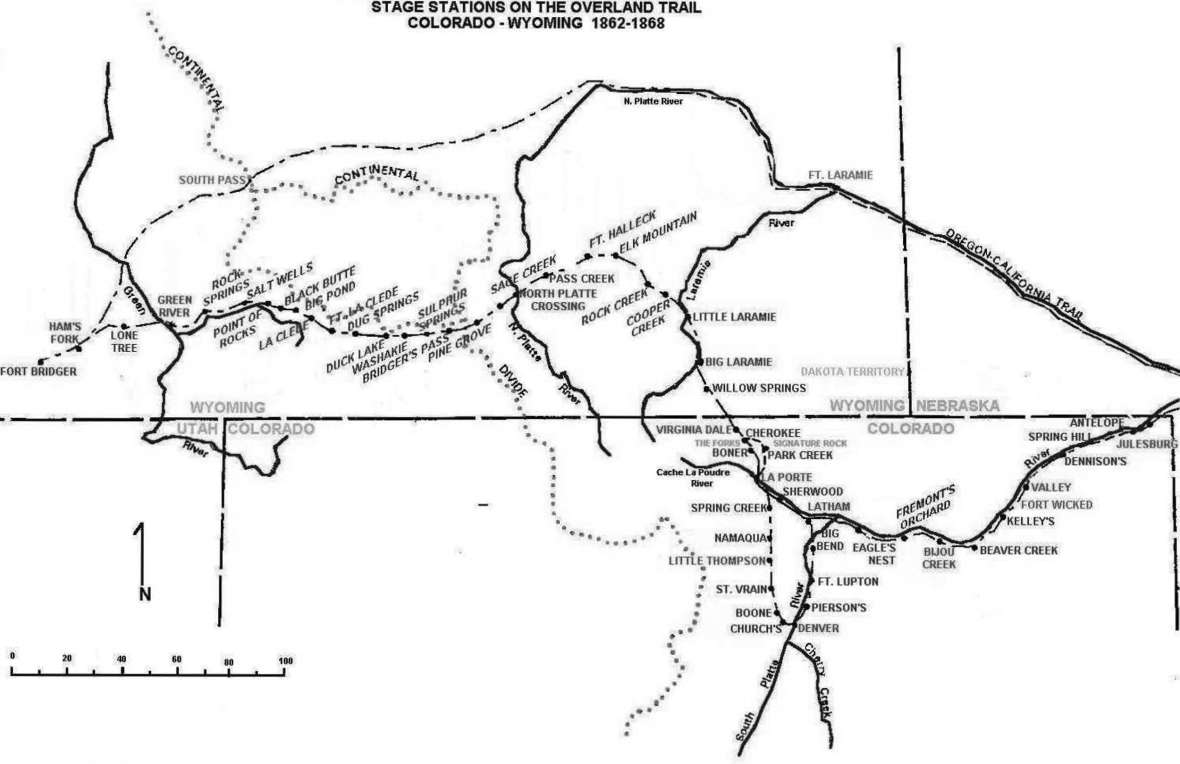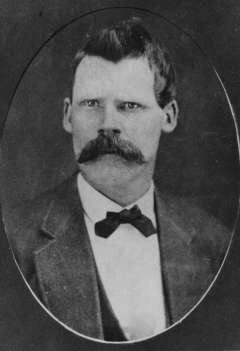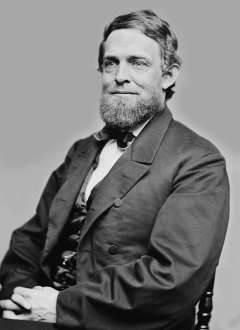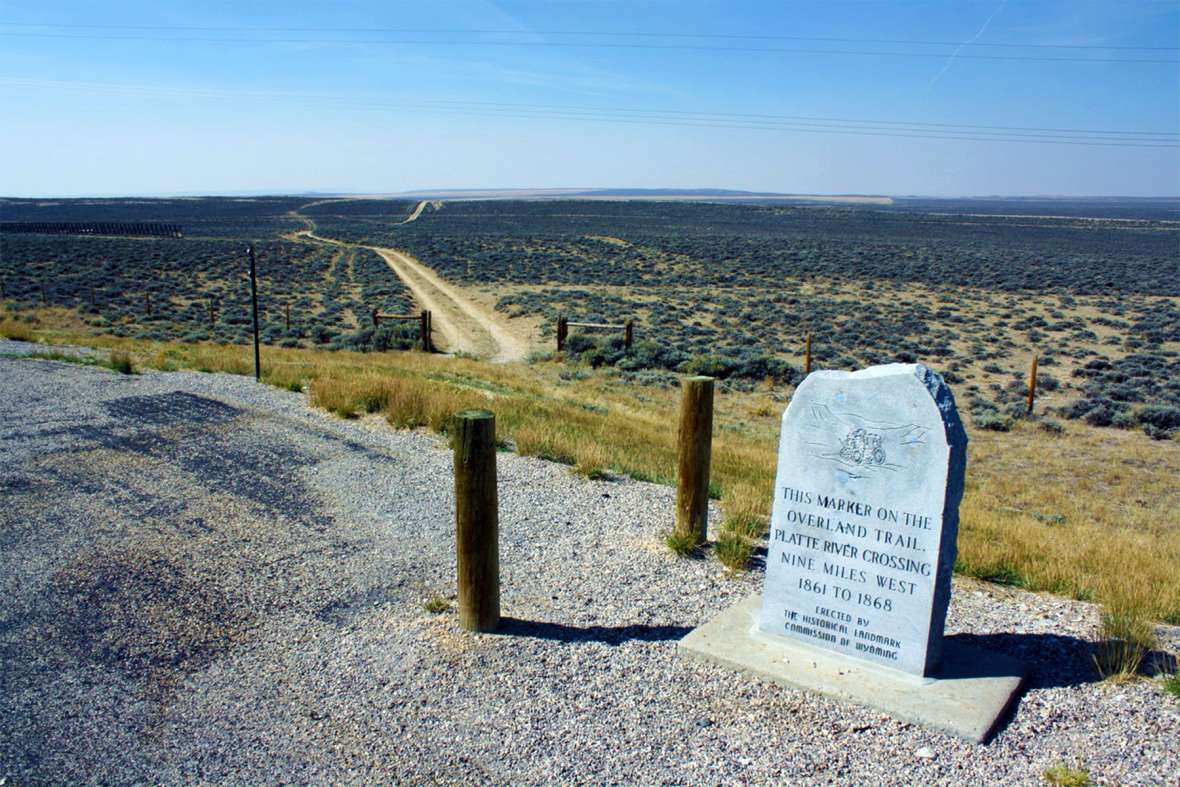- Home
- Encyclopedia
- Fort Halleck and The Overland Trail
Fort Halleck and the Overland Trail
On March 2, 1863, Lt. Col. William Collins wrote to his superior officer, stationed in Omaha, Nebraska Territory. “It had stormed more or less for two days, and on the third day (Feb. 28) a few hours after leaving camp a terrific storm came on which lasted all day and into the night. The air was so filled with snow that it was often impossible to see ten yards in any direction. … Finding it impossible to kindle a fire on account of the violence of the wind, after a delay of about half an hour the march was resumed.”
Two men froze to death on this march of 11th Ohio Volunteer Cavalry’s Companies A and C from Fort Laramie to Fort Halleck, immediately north of Elk Mountain in present south-central Wyoming.
Just the year before, stagecoach magnate Ben Holladay had changed his route from the old Oregon Trail along the North Platte and Sweetwater Rivers to a new alternative across what’s now southern Wyoming, which came to be called the Overland Trail. The trail ran up the South Platte from Julesburg through present La Porte, Colo., and then northwest along what is now U.S. 87, past Virginia Dale. When the trail reached the Laramie Plains it turned west and continued across what’s now Wyoming on a route roughly parallel to but generally 10 to 20 miles south of present I-80.
Denver’s boom was subsiding from the 1858-1861 Pike’s Peak gold rush, and Holladay now offered daily passenger and mail service from east of Denver to Salt Lake City and beyond. To serve his route through present Wyoming, he built about 17 stations, some for changing horses, and the others for passengers’ food and lodgings. All were well provisioned and had herds of horses and mules. Emigrants were still traveling west by wagon train, and commercial shipping ran both directions. Native tribes still roamed the plains, hunting, warring against other tribes and, more now as traffic increased than they had in previous decades, attacking white travelers, settlers, freighters and stagecoach stations.

Fort Halleck
With the start of the Civil War in 1861, military leaders withdrew large numbers of regular army troops from the western frontier to fight in the Union Army. This left many western Army posts undermanned, including Fort Laramie on the Oregon Trail. Their first priority was to protect the line of the new transcontinental telegraph, which ran along the Oregon Trail. It was difficult or impossible for these few soldiers to also guard the Overland Trail.
As a result, for a year or more, large stretches of both routes were undefended. President Lincoln asked Mormon leader Brigham Young for help, and during the spring of 1862, Mormon militia patrolled the Platte-Sweetwater route. They were led by Lot Smith, whose militiamen had burned U.S. Army supply wagons during the so-called Utah War just five years earlier,
The Army, meanwhile, filled its need for manpower with untried soldiers from newly recruited volunteer regiments. To defend the Overland Trail, these newcomers built Fort Halleck starting in July 1862. It was the only military post in the 350 miles between Camp Collins—later the city of Fort Collins, Colo.—and Fort Bridger in southwestern Wyoming.
Fort Halleck became a base from which soldiers regularly traveled to defend emigrants, settlers and stagecoach passengers and stations. Nearby, at the Elk Mountain station, soldiers attended dances and parties, and weddings were held. On the dark side, in addition to skirmishes with Natives in both directions along the trail, a hanging and one especially horrific episode occurred at the fort itself.

Building the Fort
The fort was named after Maj. Gen. Henry W. Halleck of the Union Army. Men from Companies A and D of the Ohio 6th Cavalry were detailed to do the work, cutting down trees from the timber on Elk Mountain’s north face. Company C arrived in early September. Maj. John O. Ferrell, the fort’s first commander, supervised the building.
Later that month, Jim Bridger guided 10 men from Fort Laramie through Sybille Canyon in the Laramie Range to Fort Halleck. In the party were Lt. Col. Collins, his nearly 18-year-old civilian son, Caspar, and eight soldiers. On Sept. 30, Caspar wrote to his mother from Fort Halleck, “Three clear streams run through the garrison. The men have their stables built, but have not got their houses done. … Some Mexican teamsters have built themselves a house, partly under ground, which can be made as hot as a bake oven by a big fireplace in one corner. … [The Army] have to haul their hay for this place about ten miles and their corn from seven hundred to nine hundred miles.”
In October, Company C left Fort Halleck for Fort Laramie. Company B of the 9th Kansas Cavalry and the new Fort Halleck commander, Capt. Aspah Allen, arrived in November. By Christmas, the men had built two sets of company quarters, two 100-horse stables, storehouses, a headquarters, an officers’ quarters, bake house, sutler store and jail. A sutler was a civilian storekeeper, granted a monopoly on sales at military posts, with prices approved by a board of officers.
Although logs were used for most of Fort Halleck’s construction, lumber was hauled in from Denver and from a sawmill at Laramie Peak. As at Fort Laramie, there was no surrounding stockade.
Chasing stolen horses
Around Feb. 18, 1863, according to soldiers then stationed at Fort Halleck, some Arapaho stole about 75 ponies from a group of Ute south of the fort. At Pass Creek stagecoach station, 10 miles west of Fort Halleck, Ute warriors asked to borrow mules from the stagecoach company to pursue the Arapaho. When the station keeper refused, the Indians reportedly took the mules anyway.
Next, Capt. Allen sent 20 men to chase the Utes and recover the mules. Only 20 men could be spared, and even this small number left the fort under-manned. Two subsequent expeditions pursued the Ute, who were chasing the Arapaho. One version of this episode notes that the Ute eventually returned the mules to the station; another says that 24 Fort Halleck men caught up with the Ute, who fled, leaving the mules behind.
When news of this unfolding event reached Fort Laramie, members of the 11th Ohio Volunteer Cavalry, including three officers, left for Fort Halleck, only to be caught in the severe blizzard in which two of the men died, and about which Col. Collins later wrote his superior. Collins himself came near to freezing to death and was briefly disabled. In the aftermath of this expedition, Dr. Andrew Holladay, brother of Ben Holladay, cared for these men at Fort Halleck.
Pressing emigrants into service
On July 16, 1863, a wagon train, including diarist F. E. W. Patten, camped at the Medicine Bow stage station, 10 miles east of Fort Halleck. There, the staff reported to the party that Indians had recently stolen horses from the Elk Mountain stage station, about a mile east of Fort Halleck. Seeing Indians near their camp, the emigrants corralled their 39 horses.
That night, responding to horse thefts throughout the area, including 200 head stolen from the vicinity of Fort Laramie, 70 enlisted men and two officers rode east from Fort Halleck. They camped near the Patten wagon train. The next day, Patten and his party continued traveling, stopping to rest at Rattlesnake Creek, six or more miles west of Fort Halleck. A messenger from the fort arrived, summoning many of the emigrants back to the fort to help defend it, since apparently only three or four soldiers remained. About 24 hours later, when the 72-man soldier party returned, Patten and his companions resumed their journey.

Another emigrant, George Bruffey, wrote that in September of that year, his train of 50 wagons, 47 men, nine women and 14 children stopped for two days at Fort Halleck. During their stay, Bruffey reported, soldiers twice raced their horses with one from the wagon train, losing both times.
Dr. John H. Finfrock arrived at Fort Halleck in October 1863 and two months later was placed on duty there as the Army physician. Physician Andrew Holladay left on Dec. 19. In 1863, the Ben Holladay stagecoach company reported losses from horses and mules stolen near Fort Halleck at about $41,400—around $871,000 today.
The first part of 1864
During 1864, spring snowstorms delayed stagecoaches and emigrants on the Overland Trail. Soldiers at the fort continued to assist civilians over the expanse of the trail and surrounding country. On March 27, Finfrock noted in his diary, “One of the worst Snow Storms of the season.” Next day, “Storm still raging but moderated.” On April 2, “Still snowing – 14 inches of snow on the ground at 8 P.M. and still snowing - no coach from East or West.”
Caspar Collins stopped at Fort Halleck on June 12 with a party escorting James A. Evans, a surveyor for the transcontinental railroad route. Collins had been commissioned a Second Lieutenant in the 11th Ohio Calvary.
The Fort Bridger sutler, William A. Carter, wrote to the commanding officer at Fort Halleck on Aug. 10, requesting an escort for his 25 wagons of supplies and ammunition, soon to be traveling from the east through the Laramie Range to Fort Halleck. Although it is not known whether men from the fort escorted these supply wagons, Carter’s request suggests the likely scope and geographical range of the soldiers’ duties.
A lynching at the fort
Finfrock had two Black servants who drove his ambulance on trips from the fort to fetch or treat a civilian. It is unclear whether these men were enlisted men, civilian employees of the Army or privately employed by Finfrock—though he kept careful accounts and never listed any payments to them.
On Sept. 25, Finfrock wrote in his diary, “Asa [one of his ambulance drivers] killed by boys of Co. D for committing rape upon little girl just 12 year old.” Another version of the episode states that Asa insulted and kissed a “white girl, with further intentions.”
Accounts of the lynching also vary, but agree that either before or after his death, Asa was skinned, and the skin fastened to a wall of the fort. Finfrock wrote, “Dissected him - Exciting time.” Finfrock's diary entries were brief and impersonal. Therefore, there's no way to know if his excitement is purely scientific or if there was a darker side to it.
British writer William Hepworth Dixon heard about the episode, commenting in his book, New America, that life in the American West was of little value compared to in England; in the West, he wrote, a white man was valued “little more than a horse and a black man less than a dog.”
Another wintry march
On Nov. 16, 1864, Company K of the 11th Ohio Cavalry was officially transferred from Fort Laramie to Fort Halleck. These 75 soldiers and two officers began their march three days later. Snow covered the ground, and the men had to dig through the snow to make a bare place for their sleeping bags. After five days of hard travel, sometimes with not even a campfire at night, all the men reached Fort Halleck on Nov. 24.
That day, Sgt. Lewis Byram Hull, quartermaster of Company K, noted in his diary, “Have to go into open quarters without bunks, tables, or floors, the Iowa boys [Company D of the 7th Iowa Volunteer Cavalry] having taken everything out when they heard we were coming. Take everything into our own quarters to keep it from being stolen.”
Apparently, the Iowa men had to camp outside for a few days until Capt. J. L. Humfreville, the new post commander, arrived from Fort Laramie with the payroll he’d traveled to Denver to collect. Then Iowa Company D could leave with their commander, Capt. W. D. Fouts. Humfreville brought 13 more Company K soldiers, raising the strength of the garrison to 91.
Finfrock noted emigrants passing Halleck in 1864: “Waggons, 4264, Stock 50000, Men, etc 17584.”
Fort Halleck in 1865
Company K, before having to fight any resistance from the tribes, battled cold and snow through mid-April 1865. Many stagecoaches were delayed, and two Company K men froze to death in a storm while guarding Fort Halleck cattle, horses and mules pastured east of the fort.
Quartermaster Hull wrote on March 8, “Cold and very stormy. Can not see the mountains for the snow. … No wood in Post; all playing ‘freeze out.’” Next day he continued, “[N]o wood yet; have to tear down old shop for fuel to keep from freezing. Too cold to work, so go to bed to keep warm. No coaches; roads completely blockaded.”
Evidently, later that month freighters delivered a large load of corn. On March 22, Hull wrote, “Commence moving corn pile; a great many open sacks and considerable loose corn.” He spent the next week and more dealing with it, on March 29 noting, “Clear the snow off the corn pile and cover it with canvas.” On April 4, he was still shoveling corn.
On April 9, Lee surrendered to Grant at Appomattox, effectively ending the Civil War.
A hanging
On May 13, Bob Jennings, a trapper and Southern sympathizer, shot Horace “Hod” Russell, who sometimes cooked at Fort Halleck for the men. Russell and his wife also kept a boardinghouse at the Elk Mountain stagecoach station, and periodically welcomed the soldiers and other residents of the fort to their home for dances.
Russell often traveled to Denver for supplies, and may have been on one of these trips when he stopped at the Cooper Creek station about 27 miles east of Fort Halleck. Sources differ on the story of the murder: one says Jennings ambushed Russell and another that the two men got into an argument. The stationmaster’s wife at Cooper Creek witnessed the shooting.
William Averell “Medicine Bill” Comstock, an army scout and friend of the Indians, hunted Jennings down, helped by a few Arapaho scouts. On May 20, they turned him in at Fort Halleck. Capt. Humfreville presided over the trial the next day. While the stationmaster’s wife, Mrs. Fisk, was traveling to the fort to testify, he was sentenced to be hanged. “Sentence executed between one and two,” Quartermaster Hull wrote. “[S]aid that he did murder Russell and was not sorry for it. His last words were ‘Hurrah for Jeff Davis and the Southern confederacy.’”
“Give Indians a large quantity of corn,” Hull added. “Plenty of them around, big, little, old and young.”
Retribution for the Sand Creek massacre
In 1865, a wave of Indian attacks broke across the whole region, in reaction to the Sand Creek massacre of the previous November, in which Col. John Chivington and his men killed about 135 peaceful Cheyenne and some Arapaho, including many women and children, at a camp on Sand Creek in southeastern Colorado.
In July, Arapaho warriors would join thousands of their Cheyenne and Lakota Sioux allies from farther north to attack Platte Bridge Station at present Casper, Wyo. Caspar Collins and two dozen other soldiers were killed. In August, Brigadier Gen. Patrick Connor led a huge, three-pronged Army expedition north into the Powder River Basin—with entirely inconclusive results.

War intensified along the Overland Trail as well. On June 2, 1865, Hull wrote, “Messenger down from Platte [stage station] for assistance; says Indians are running off stock and killing station keepers. Lt. Brown and thirty men go up to see what the trouble is. Captain [Humfreville] gone to Rock creek.” The Platte station was about 30 miles west of Fort Halleck.
The worst battle occurred at the Sage Creek station, another three miles west of the Platte station. Lt. Brown wrote to Capt. Humfreville on June 14, “After an hour’s severe fighting … [the Company K detachment] were compelled to evacuate. … The moment they left the station they were completely surrounded. There ensued a desperate fight; the detachment retreated [a few miles west] toward Pine Grove Station.” Naming seven men killed, wounded or missing, and further describing the battle’s aftermath, Brown concluded, “Ten of the men have returned to this post [Fort Halleck]; the balance are doing all they can to keep open the road, but the force is inadequate to cope with the number of Indians.”
The Colfax excursion
About a month previously, on May 20, 1865, U.S. Speaker of the House Schuyler Colfax left Atchison, Kan., bound for California on a trip to gather information for a Joint Senate and House Committee to recommend changes in the government’s policy toward the Indians. Despite news of Indian attacks all along the stagecoach route they were to travel, Colfax’s party continued west.
They arrived at Fort Halleck on June 6. Ten men and two officers escorted them to the Bridger Pass stage station, about 50 miles southwest near the Continental Divide, during the same time Indians were attacking stations all along the Overland Trail. Colfax and his companions reached Salt Lake City safely and continued on to California without incident.
Change of men
Company K of the 11th Ohio left Fort Halleck for Fort Laramie in late June and was replaced by five companies of the 11th Kansas Volunteer Cavalry. This brought more men, of greater experience, to patrol and defend the Overland Trail, just before Indian attacks tapered off in the fall.
Civilians employed at the fort in 1865 were a clerk, storekeeper/forage master, blacksmith and guide.
The final half-year
Information is sparse on the last six months at Fort Halleck. Apparently, compared to 1865, it was a much quieter duty for the various troops serving there. The last soldiers to arrive, on June 19, 1866, were the 18th U.S. Infantry, Companies A and F, commanded by Capt. Henry R. Mizner. The fort was decommissioned on July 4. The 5th U.S. Volunteers Squad F, who had been there since the previous November, remained until July 14, dismantling the buildings to transport the materials to Fort John Buford, soon to be named Fort Sanders, near present Laramie, Wyo.
In all, about 23 companies of cavalry regiments from Ohio, Kansas, Iowa, Michigan and New York, plus some U.S. cavalry and U.S. volunteer companies, served at Fort Halleck during its four years.
Exhuming graves
By 1878, the cemetery at Fort Halleck had no fence, and livestock were grazing in it. The Army disinterred 40 graves, including some civilians, on Jan. 4, 1879, re-interring these remains in the Fort McPherson National Cemetery in Nebraska.
Although relatively little information is available about Fort Halleck, it was a crucial military post whose soldiers helped maintain what safety was possible on a long, dangerous thoroughfare.

Resources
Primary Sources
- Brown, James. Report to Capt. Jacob Humfreville. June 14, 1865. In Cullimore, Lee M. The Boys of Company K: Ohio Cavalry Soldiers in the West During the Civil War. Glendo, Wyo.: High Plains Press, 2012, 191-192.
- Bruffey, George A. Eighty-One Years in the West. Bethesda, Md.: A microfiche project of University Publications of America, 1998. In Kinnaman, Daniel L. A Little Piece of Wyoming. Rawlins, Wyo.: Kinnaman Publications, 1996, 60.
- Collins, Caspar. Letter to his mother. Sept. 30, 1862. In Kinnaman, Daniel L. A Little Piece of Wyoming. Rawlins, Wyo.: Kinnaman Publications, 1996, 54.
- Collins, William Oliver. Letter to Gen. James Craig. March 2, 1863. In Cullimore, Lee M. The Boys of Company K: Ohio Cavalry Soldiers in the West During the Civil War. Glendo, Wyo.: High Plains Press, 2012, 124-126.
- Dixon, William Hepworth. New America. 1867. Reprint. N.p. Forgotten Books, 2016. In Kinnaman, Daniel L. A Little Piece of Wyoming. Rawlins, Wyo.: Kinnaman Publications, 1996, 76.
- Finfrock, John H. Diary. 1863-1864. Box 7, Finfrock Family Papers, American Heritage Center, University of Wyoming, Laramie, Wyo. (Hereafter AHC).
- Fort Halleck Photofile, AHC.
- Hull, Myra E., ed. “Soldiering on the High Plains: The Diary of Lewis Byram Hull, 1864-1866,” Kansas Historical Quarterly 7, 1938, accessed March 7, 2020 at http://www.kancoll.org/khq/1938/38_1_hull.htm.
- Patten, F.E.W. Diary. 1863. In Kinnaman, Daniel L. A Little Piece of Wyoming. Rawlins, Wyo.: Kinnaman Publications, 1996, 58.
Secondary Sources
- Bagley, Will. “Fort Bridger.” WyoHistory.org, accessed April 13, 2020 at /encyclopedia/fort-bridger.
- Colorado Encyclopedia. "Colorado Gold Rush," Jan. 7, 2020, accessed April 3, 2020 at https://coloradoencyclopedia.org/article/colorado-gold-rush.
- Cullimore, Lee M. The Boys of Company K: Ohio Cavalry Soldiers in the West During the Civil War. Glendo, Wyo.: High Plains Press, 2012, 119-129, 161-197.
- Frazer, Robert W. Forts of the West: Military Forts and Presidios and Posts Commonly Called Forts West of the Mississippi River to 1898. Norman, Okla.: University of Oklahoma Press, 1965, 181.
- Kinnaman, Daniel L. A Little Piece of Wyoming. Rawlins, Wyo.: Kinnaman Publications, 1996, 41, 52-105.
- Morton, Julius Sterling, Albert Watkins, and George L. Miller. Illustrated History of Nebraska, Vol. 1. 3rd. ed. Lincoln: Western Publishing and Engraving Co., 1911, 349-350, accessed March 9, 2020 at https://books.google.com/books?id=hHkUAAAAYAAJ&pg=PA350&lpg=PA350&dq="dr.+Holladay"+nebraska&source=bl&ots=w2tr_SdstJ&sig=ACfU3U0aWGdlEUHVfmm67N1KXI4AoFguzg&hl=en&sa=X&ved=2ahUKEwi-sabUqo3oAhU_CjQIHdLkAicQ6AEwBXoECAkQAQ#v=onepage&q="dr.%20Holladay"%20nebraska&f=false.
- Murray, Robert A. Military Posts of Wyoming. Ft. Collins, Colo.: The Old Army Press, 1974, 53.
- Palmieri, Dr. Anthony and Chris Humberson. “Medical Incidents in the Life of Dr. John H. Finfrock.” Annals of Wyoming 53, no. 2 (Fall 1981): 64-69, accessed April 1, 2020 at https://archive.org/details/annalsofwyom53121981wyom/.
- "Pike's Peak Gold Rush." Wikipedia, accessed April 28, 2020 at https://en.wikipedia.org/wiki/Pike's_Peak_Gold_Rush.
- Strayer-Hanson, Frances. Medicine Valley Pioneers: Closing the Overland Trail, Opening the Union Pacific Railroad. Bloomington, Ind.: iUniverse, 2009, 93-96.
Illustrations
- The drawing of Fort Halleck by Bugler C. Moellman of the 11th Ohio Cavalry and the photo of Dr. John Finfrock are from the archives of the American Heritage Center at the University of Wyoming. Used with permission and thanks.
- The map of the Overland Trail is from a U.S. Forest Service website. Used with thanks. Click here to see a version of the map with many more tales of the Overland Trail attached.
- The photo of Schuyler Colfax is from Wikipedia. Used with thanks.
- The photo of the Overland Trail marker, where the trail crosses Wyoming Highway 130 north of Saratoga, is by Tom Rea.
